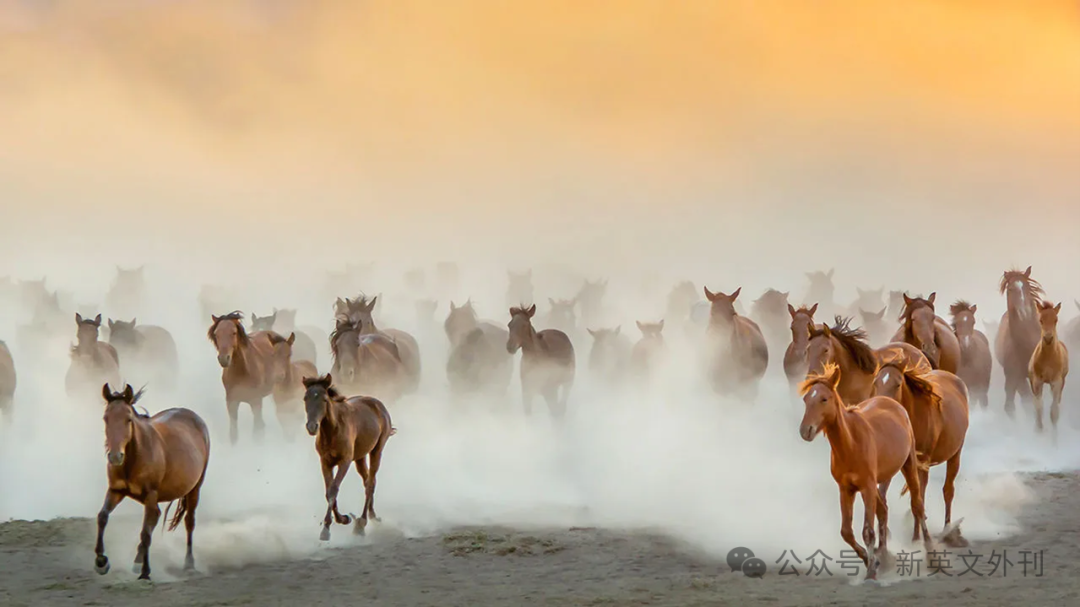📢 文末扫码进裙,免费领取双语精读版
One of history’s biggest drivers is not what you might think
The horse has moulded empires, wars and human affairs profoundly.

19 Sep, 2024 | 833 words | ★★★★☆There was nearly a world without horses. At the end of the last ice age warming temperatures turned the grasslands where horses roamed into swamps and forests. Humans hunted them heavily for meat. Wild horses did, in fact, go extinct in North America around 7,600-12,000 years ago . You could say that by stopping hunting and starting to domesticate and harness them, humans saved horses. Or you could say that horses decided to bet on people.
Humans were forever changed by their equine alliance. Able to gallop at more than 40mph (64kph) and to convey heavy objects, horses altered the arc of empires and determined victors and losers in battle. Timothy Winegard, a historian, calls horses “humanity’s longest-serving weapon system”. They also transformed the way people could hunt, communicate, trade and even dress. Trousers spread only after horses were domesticated, as an innovation for riding. The oldest surviving pairs, dating to 1300 BC, belonged to horsemen.
A herd of new books has come out looking at the horse’s impact on human history, though their approaches are very different. David Chaffetz, a scholar of Asian history, focuses his deeply researched, elegantly written “Raiders, Rulers and Traders” on the interplay between horse-borne nomads and settled peoples, a defining aspect of Chinese, Indian and Persian civilisations. He argues that “What we now call the Silk Road should more accurately be called the Horse Road, for it was the horse, and not silk, that drew buyers and sellers together…to form the first large-scale international trading routes.”
The broadest and most accessible view comes from Mr Winegard. Ranging from horse anatomy to the role of horses in both world wars, his book is packed with fascinating detail. For example, by weight, Britain shipped more horse feed than ammunition to the western front in the first world war; 20 years later Hitler enlisted some 2.7m horses in the second. In contrast, “Hoof Beats” by William Taylor, an academic and curator at the University of Colorado Museum of Natural History, is based primarily on archaeology; unfortunately it reads like a competent textbook.
All three books consider how mastery of the horse empowered the people who first achieved it in the third millennium BC. Their homeland was the Pontic-Caspian steppe, the vast grasslands north of the Black and Caspian seas. Using horses for food, transport and warfare provided mobility and an edge over others. One result is that their language, Proto-Indo-European, forms the root of tongues spoken by 46% of people today, such as Bengali and Portuguese. Their genetic imprint stamps 40-50% of Europeans. Some 60-90% of men on the Indian subcontinent can trace patrilineal DNA back to these early horsemen.
Superior horses and horsemanship continued to determine sweeping population movements. By around 2000 BC horses had trampled older civilisations across Europe and India, such as those that built Stonehenge in England and Mohenjodaro in the Indus Valley. Mastery of mounts brought the Huns into Europe (around 370 AD), the Arabs into Spain (711 AD) and the Turks into India (1020 AD) and Anatolia (1071 AD). Horses also spread the vast Mongol armies under Genghis Khan across nearly the whole of the Eurasian land mass, including China (around 1200 AD).
In Europe feudalism and chivalry arrived on horseback, as did Napoleon’s troops. According to Mr Winegard, in the French army’s disastrous retreat from Moscow in 1812 it was the loss of 200,000 horses, which could not be quickly replaced, rather than of half a million soldiers who could, that sealed the emperor’s fate.
A look at the “biotechnology” of the horse explains its usefulness. In terms of power a horse packs more than ten times that of a human. (People still use “horsepower” as a way to quantify might.) Horses hardly need sleep, run fast for long stretches and have temperaments that make them easy to herd and train. Their teeth snip grass with front incisors and crush it with back molars, leaving a useful gap for a bit. Their milk has five times more vitamin C, and their flesh more protein, than cows’. Handy “hardware” like stirrups and saddles, as well as the innovation of hitching horses to wheeled vehicles (from around 2000 BC), have given people more control.
Horses’ utility translated into muscular pricing. An ordinary mount in ancient Athens cost upwards of 500 drachmas, compared with 140 for an unskilled slave. In Brazil in the 17th century a fine steed could fetch as much as 20 slaves. It is only in the past 100 years, since the invention and spread of automobiles, that horses became less integral to human civilisation and people’s daily lives. However, as these books make clear, it would be unwise to put horses out to pasture in people’s memories. They deserve enduring respect, for their hoof beats changed the world. ■

——新英文外刊,全网最大的外刊学习平台,每日精选优质外刊学习文章,文章质优、话题丰富、时效最新,始于2016年3月。















